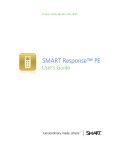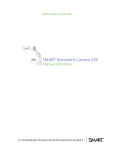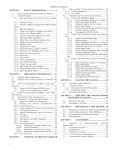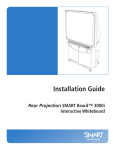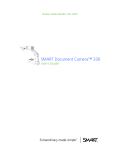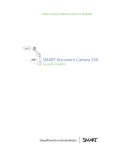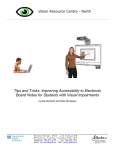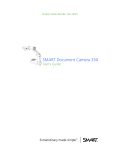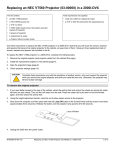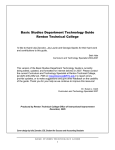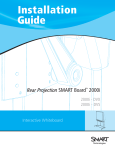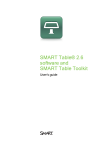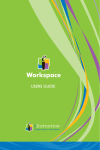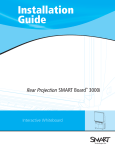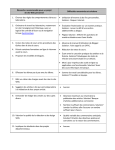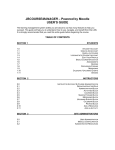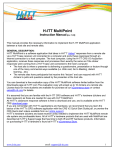Download Senteo - SMART Technologies
Transcript
User’s Guide interactive response system Trademark Notice SMART Board, the SMART logo, Senteo, Notebook and smarttech are trademarks or registered trademarks of SMART Technologies ULC in the U.S. and/or other countries. Microsoft, Windows and PowerPoint are either registered trademarks or trademarks of Microsoft Corporation in the U.S. and/or other countries. Mac is a registered trademark of Apple Computer, Inc., registered in the U.S. and other countries. All other third-party product and company names may be trademarks of their respective owners. Contents are subject to change without notice. Copyright Notice © 2007–2008 SMART Technologies ULC. All rights reserved. The use and copying of Senteo software is subject to a license agreement. Any other use is prohibited. No part of this publication may be reproduced, transmitted, transcribed, stored in a retrieval system or translated into any language in any form by any means without the prior written consent of SMART Technologies ULC. Information in this manual is subject to change without notice and does not represent a commitment on the part of the vendor. 03/2008 If you have any questions about what constitutes legal use of this product please consult the license agreement that came with your original software or contact SMART Technologies ULC. Important Information Before you use the SMART Senteo interactive response system, please read and understand the safety warnings and precautions described in this guide. These safety warnings and precautions instruct you in the safe and correct operation of the system and its accessories so you can prevent injuries to yourself, others or damage to the equipment. You must always ensure that the Senteo interactive response system is being used correctly. NOTE: If you own a SMART product other than a SMART Senteo™ interactive response system, refer to the user’s guide that came with your product for relevant warnings and maintenance instructions. Safety Warnings WARNING WARNING WARNING WARNING CAUTION Failure to follow the installation instructions that ship with the SMART product could result in personal injury or damage to the product. When using the Senteo interactive response system with a SMART Board™ interactive whiteboard and projector, do not stare into the beam of light created by the projector. Instruct children not to look in the direction of, or stare at, this beam of light. Ensure that any cables extending across the floor to your SMART product are properly bundled and marked to avoid a trip hazard. To reduce the risk of fire or electric shock, do not expose the components to rain or moisture. Use only the batteries provided or equivalent replacements. Do not attempt to recharge the batteries. CAUTION Do not install batteries with the polarity (+/–) reversed. CAUTION Do not dispose of batteries in a fire or incinerator. Dispose of batteries according to the laws and regulations of your region. If you don’t know the applicable rules for your region, consult the battery manufacturer. Important Information i CAUTION CAUTION Never use abrasive erasers or harsh chemicals when cleaning Senteo interactive response system hardware. Do not open the receiver or clicker units to attempt repairs. Refer all service to authorized SMART service personnel. IMPORTANT You must connect the USB cable that came with your SMART product to a computer that has a USB compliant interface and that bears the USB logo. In addition, the USB source computer must be compliant with CSA/UL/EN 60950 and bear the CE mark and CSA and/or UL Mark(s) for CAS/UL 60950. This is for operating safety and to avoid damage to the SMART product. IMPORTANT If your SMART product requires replacement parts, make sure the service technician uses replacement parts specified by SMART Technologies ULC or parts with the same characteristics as the original. Compliance This device complies with Part 15 of the FCC rules. Operation is subject to the following two conditions: 1. This device may not cause harmful interference, and 2. This device must accept any interference received, including interference that may cause undesired operation. Changes or modifications to this equipment not expressly approved by SMART Technologies ULC may void the user’s authority to operate this equipment. NOTE: This equipment has been tested and found to comply with the limits for a Class B digital device, pursuant to Part 15 of the FCC Rules. These limits are designed to provide reasonable protection against harmful interference in a residential installation. This equipment generates, uses, and can radiate radio frequency energy and, if not installed and used in accordance with the instructions, may cause harmful interference to radio communications. However, there is no guarantee that interference will not occur in a particular installation. If this equipment does cause harmful interference to radio or television reception, which can be determined by turning the equipment off and on, the user is encouraged to try to correct the interference by one or more of the following measures: ii • Reorient or relocate the receiver or clicker units. • Increase the separation between the equipment and the product. • Connect the affected equipment into an outlet on a circuit different from that to which the receiver’s computer is connected. • Consult your SMART service representative or an experienced radio/TV technician for help. Important Information Table of Contents Important Information i Safety Warnings ................................................................................................................................i Compliance ......................................................................................................................................ii About the Senteo Interactive Response System 1 Overview ......................................................................................................................................... 1 Features .......................................................................................................................................... 1 Section 1: Installing the Senteo Interactive Response System Environmental Requirements.......................................................................................................... 3 Temperature ............................................................................................................................. 3 Humidity.................................................................................................................................... 3 Water and Fluid Resistance...................................................................................................... 3 Dust and Scratching ................................................................................................................. 3 Electrostatic Discharge (ESD) .................................................................................................. 3 Conducted and Radiated Emissions ........................................................................................ 3 Installing Senteo Assessment Software 4 System Requirements..................................................................................................................... 4 Contacting SMART Technologies ................................................................................................... 4 Senteo Assessment Software Components.................................................................................... 5 Activating Senteo Assessment Software ........................................................................................ 6 Installing and Setting Up Senteo Interactive Response System Hardware 8 Connecting the Receiver to a Computer ......................................................................................... 8 Recommended Height for Mounting the Receiver.................................................................... 8 Extending the USB Cable ......................................................................................................... 9 Renaming the Classroom.............................................................................................................. 10 Section 2: Managing Senteo Interactive Response System Hardware Checking the Receiver ...................................................................................................................11 Selecting Receiver Channels .........................................................................................................11 Selecting the Operating Mode....................................................................................................... 12 Starting in On (Anonymous) Mode ................................................................................................ 13 Starting in On (Sign In Required) Mode ........................................................................................ 13 Locking Sign In.............................................................................................................................. 14 Setting Advanced Options............................................................................................................. 14 Managing Class Lists 16 Creating Class Lists ...................................................................................................................... 16 Importing Class Lists..................................................................................................................... 17 Importing Class Lists from Microsoft Excel® Software (Windows Operating Systems Only) . 17 Importing Class Lists From a CSV File................................................................................... 17 Modifying Class Lists .................................................................................................................... 18 Connecting and Disconnecting the Clickers 20 Connecting Clickers in On (Anonymous) Mode ............................................................................ 20 Connecting Clickers in On (Sign In Required) Mode .................................................................... 20 Disconnecting the Clickers............................................................................................................ 21 Table of Contents iii Section 3: Using Senteo Software with Notebook and PowerPoint Software About SMART Notebook Software................................................................................................ 23 Notebook Software with Senteo Assessment Software ................................................................ 23 Using Notebook Software to Ask Questions and Create Question Sets 24 Question Types ............................................................................................................................. 24 Asking Questions with Notebook Software ................................................................................... 24 Creating Question Sets with Notebook Software .......................................................................... 26 Importing Questions from Microsoft Word..................................................................................... 28 Example Word Document Question Formats ......................................................................... 28 Importing Questions from XML or SQZ Files ................................................................................ 30 Printing from Notebook Software’s Senteo Menu ......................................................................... 31 Using Senteo Assessment Software in the Classroom 32 Before Class Begins...................................................................................................................... 32 Choosing a Startup Sequence ...................................................................................................... 32 Turning On the Receiver Before Starting Questions............................................................... 33 Turning On the Receiver After Starting a Question Set .......................................................... 33 Using the Clickers ......................................................................................................................... 34 Clicker Buttons and Features ................................................................................................. 34 Receiving Student Questions ................................................................................................. 35 Using the Menu Button ........................................................................................................... 35 Starting a Question Set ................................................................................................................. 36 Using Instant Questions ................................................................................................................ 37 Viewing, Printing and Exporting Results ....................................................................................... 38 Using Senteo Assessment Software with Microsoft PowerPoint Software 39 Section 4: Maintaining the Senteo Interactive Response System Preventing Component Damage................................................................................................... 41 Cleaning the Receiver and Clickers ....................................................................................... 41 Changing Clicker Batteries............................................................................................................ 41 The Receiver Indicators ................................................................................................................ 42 Troubleshooting the Receiver ....................................................................................................... 42 Resetting the Receiver ........................................................................................................... 42 Troubleshooting Using the Receiver Lights ............................................................................ 43 Transporting the Senteo Interactive Response System ................................................................ 43 Waste Electrical and Electronic Equipment Regulations 44 Customer Support 45 Online Support .............................................................................................................................. 45 Training ......................................................................................................................................... 45 Contacting SMART Technical Support .......................................................................................... 45 General Inquiries........................................................................................................................... 45 Warranty........................................................................................................................................ 46 Registration ................................................................................................................................... 46 Sending Feedback ........................................................................................................................ 46 Obtaining More Information........................................................................................................... 46 iv About the Senteo Interactive Response System Overview The Senteo interactive response system is an assessment tool designed to enhance learning. It facilitates summative and formative assessment by allowing you to pose a question before, during or after a lesson to find out if students are on track. You can use the feedback to help shape the rest of your lesson. Once you’ve finished the lesson, you can create a question set with Senteo assessment software to evaluate learning more formally. You can feel confident that the students have answered the way they intended because they can verify and change their self-paced responses directly on the remote. You can easily add creativity to questions by combining text with images to make questions more dynamic. Senteo software comes with Notebook™ collaborative learning software and offers 6,000 learning objects that can be easily added to quizzes. You can write and edit notes in digital ink, import or export Microsoft® PowerPoint® presentations, and incorporate multimedia content. The Senteo interactive response system increases one-to-one interaction by allowing you to survey and engage students and collect responses. You can use student feedback to plan lessons and personalize the learning environment. Features • Flexible package options The Senteo interactive response system includes a receiver and clickers, and is available in 24- or 32-unit packages. You can also purchase receivers individually, and clickers in packs of one and five units. • Cross-platform support You can use the Senteo interactive response system with Microsoft Windows and Mac OS operating systems. • Notebook software resources Use Notebook software objects to build dynamic questions with images and other multimedia content. • Flexible assessment options You can prepare quizzes in advance or ask instant questions. • Question variety Ask true or false, yes or no, multiple choice, numeric response and more-than-one right answer questions. You can also incorporate decimals, fractions and negative numbers into questions. • Instant feedback You can see how well students understand what you’ve taught them immediately. You can get feedback in bar graphs or pie charts summarizing the results from one question or all of them. You can also see responses from individual students. • Import questions from other applications You can import questions from Microsoft Word or questions in XML format. Senteo software also integrates with PowerPoint presentation software. • Export results You can export student answers from the Senteo interactive response system to an Excel spreadsheet, a comma separated value (CSV) file or an HTML Web page. About the Senteo Interactive Response System 1 • Print question sets and study guides Senteo assessment software allows you to print question sets as handouts so students can complete them at their own pace. You can also print result summaries so each student knows which questions they got right or wrong. You can also add teacher comments and use the summaries as study guides. • Radio frequency technology The Senteo interactive response system’s robust radio frequency technology has a range of up to 100 ft. (30 m) and doesn’t need a line-of-sight path. Clicker Features • Large LCD screen The screen displays three lines of text. • Descriptive icons LCD screen icons show battery and connection status. • Ergonomic design The handheld clicker is designed to fit comfortably in young hands, and the 21 input buttons are conveniently located and easy to use. • Extended battery life Each clicker uses two AA batteries, which are long-lasting and easy to replace. Receiver Features 2 • Convenient connection The receiver connects easily using a standard USB connection and doesn’t need an additional power adaptor. • Flexible installation The receiver can be either mounted on a wall or placed on a desk. • Convenient maintenance features LED lights indicate power status and give visual indications of sent and received information. About the Senteo Interactive Response System Section 1: Installing the Senteo Interactive Response System Environmental Requirements Before installing or using your Senteo interactive response system, review the following environmental requirements and compliance statements. Temperature Senteo interactive response system components can operate in the temperature range of 41°F to 95°F (5°C to 35°C). In addition, the product can withstand storage temperatures from -40°F to 120°F (-40°C to 50°C). Humidity Senteo interactive response system components can operate in up to 80% relative humidity non-condensing. Water and Fluid Resistance Senteo interactive response system components are for indoor use only and do not meet any saltspray or water ingress requirements. Do not pour or spray any liquids directly onto the Senteo interactive response system components. These liquids might get into areas where they could damage sensitive electronic components. Refer to page 41 for detailed instructions on cleaning your Senteo interactive response system components. Dust and Scratching Senteo interactive response system components are for use in office and classroom environments and are not for industrial use where heavy dust and pollutants can cause malfunctions or impaired operation. They are designed for pollution degree 1 (P1) as per EN61558-1, which is defined as “No pollution or only dry non-conductive pollution.” Electrostatic Discharge (ESD) Senteo interactive response system components meet the requirements of EN61000-4-2 severity level 4 for direct and indirect ESD. No malfunction or damage up to 15kV (both polarities) with a 330 ohm, 150 pF probe (air discharge). Un-mated connectors meet 8kV for direct (contact) discharge. Conducted and Radiated Emissions The narrowband radiated electric field from Senteo interactive response system components meets the limits for Class B performance as defined in EN55022/CISPR 22. Installing the Senteo Interactive Response System 3 Installing Senteo Assessment Software System Requirements Windows Computers Pentium® II 450 MHz processor 128 MB of RAM (256 MB recommended) 136 MB of free hard disk space for minimum installation (511 MB for full installation with Gallery collections) Windows 2000 operating system or later Microsoft Internet Explorer® 6.0 or later Adobe® Flash® player version 9 Mac Computers 700 MHz processor (1 GHz or faster recommended) 128 MB of RAM (256 MB recommended) Mac OS X versions 10.4.8 through 10.4.10 180 MB of free hard disk space for minimum installation (511 MB for full installation with Gallery collections) Adobe Flash player version 9 Contacting SMART Technologies Visit SMART’s support site at www.smarttech.com/support to check for software upgrades, including SMART Board software and Senteo assessment software. You’ll find installation and user's guides, “how-to” and troubleshooting articles, solutions for your SMART product, and answers to your questions. You can also use SMART’s support site to contact technical support. 4 Installing Senteo Assessment Software Senteo Assessment Software Components In the following procedures, you will install all of these software components: • Senteo Manager • Driver software for the receiver • Notebook software, including the Senteo assessment software menu To install Senteo assessment software on Windows computers 1. Put the Senteo assessment software CD into your computer’s drive. The installation wizard appears. If it doesn’t start automatically, locate and double-click the SenteoSoftwareSetup.exe file on the CD. 2. Click Install Senteo Software to start the wizard, and then click Next. The Licence Agreement dialog box appears. 3. Select the I accept option, and then click Next. 4. Click Next to install the software to the default folder. 5. Click Install to start the installation. 6. Click Finish. 7. Select the options to check for program updates and install SMART Essential for Educators as desired, click Next, and then click Finish to complete the installation. If your computer is connected to the Internet, after a short delay, the SMART Product Update dialog box appears. 8. If updates are available, click Update, and then click Close. A balloon message appears in the notification area. 9. Click the balloon message to create a classroom. A dialog box appears. 10. Type a unique classroom name into the box, and then click OK. NOTE: The OK button is disabled until you type a valid classroom name. 11. Click Finish to complete the installation. To install Senteo assessment software on Mac computers 1. Insert the Senteo interactive response system CD into your computer’s CD drive. A Senteo CD icon appears on the desktop. 2. Double-click the Senteo CD icon. The Senteo window appears. 3. Double-click the Senteo box icon. The Install Senteo dialog box appears. 4. Click Continue, and then click Continue again. The Software License Agreement page appears. 5. Click Continue, and then click Agree, if you agree with the terms of the license agreement. 6. If there is more than one volume, select the volume that you want to install the Senteo software on, and then click Continue. Installing Senteo Assessment Software 5 7. Click Install to start the installation. NOTE: If the installer asks you, type your password, and click OK. 8. Click Continue Installation to complete the installation. If your computer is connected to the Internet, the SMART Essentials for Educators dialog box appears. Select the categories you want to install, and then click Next. The SMART Product Update dialog box appears. If your computer is connected to the Internet, the dialog box displays the current versions of your SMART product software, and displays the latest updates available for download from SMART’s website. 9. If software updates are available, click Update. OR If software updates aren’t available, or if you don’t want to update your software, click Close. After a short delay, a message appears asking you to restart your computer. 10. Click Restart. Activating Senteo Assessment Software You must register your Senteo assessment software within 30 days of installation to keep it active. You need a license code to activate your software. Using the following procedure, you can find your license code. You must connect your computer to the Internet and connect the Senteo receiver to your computer before you can search for a license code. After you complete the following procedure to find your license code, you can use the code to activate Senteo software on other computers, as outlined in the License tab in the About Senteo Assessment Software dialog box. NOTE: After you find your license code, you don’t need to connect the Senteo receiver to the other computers you want to activate Senteo assessment software on. To find your license code and activate Senteo assessment software 1. Click the Senteo icon in the Windows notification area or Mac menu bar, and then select Activate Senteo Assessment Software. The Software Evaluation dialog box appears displaying your time remaining in the software evaluation period. NOTES – If your 30-day evaluation expires, Open Notebook Software, Activate Senteo Assessment Software and Exit appear as the only available commands in the Senteo menu. – If your Senteo assessment software is already activated, the Activate Senteo Assessment Software command is replaced by Check for Updates. 2. Click Activate License. 3. If a dialog box appears requesting a password, type an administrator’s password. 4. Click Find License Code. NOTE: You must connect your computer to the Internet and connect the Senteo receiver to your computer before you can search for a license code. 6 Installing Senteo Assessment Software 5. Click Find License Code. The license code appears. NOTE: If you didn’t connect the receiver, a warning dialog appears. 6. Record the license code in a safe place, and then click Close. You’ll need your license code to activate Senteo assessment software on your other computers. The activation program automatically copies the license code into the License Code box. 7. Type your e-mail address, and then click Next. 8. Select Yes, I am connected, and then click Next. 9. Click Finish to activate your Senteo assessment software. To activate Senteo assessment software on other computers After you obtain your license code, follow these steps to activate Senteo assessment software on other computers. NOTE: If the computers don’t have an Internet connection, you must contact SMART Technical Support by e-mail or telephone to get an activation key. 1. Click the Senteo icon in the Windows notification area or Mac menu bar, and then select Activate Senteo Assessment Software. The Software Evaluation dialog box appears displaying your time remaining in the software evaluation period. 2. Click Activate License. NOTE: You don’t need to connect a Senteo receiver to your computer to activate the license. 3. If a dialog box appears requesting a password, type an administrator’s password. 4. Paste or type your license code and e-mail address, and then click Next. 5. If you have an Internet connection, select Yes, I am connected, and then click Next. OR If you don’t have an Internet connection, click No, I am not connected, and then click Next. Click either the activate by phone or activate by e-mail option to request an activation key from SMART Technical Support. Type the activation key you obtain from Technical Support, and then click Next. 6. Click Finish to activate your Senteo assessment software. Installing Senteo Assessment Software 7 Installing and Setting Up Senteo Interactive Response System Hardware Connecting the Receiver to a Computer IMPORTANT For operating safety and to avoid damage to the receiver, you must connect the USB connector of the interactive whiteboard only to a computer that has a USB compliant interface and that bears the USB logo. In addition, the USB source computer must be compliant with CSA/UL/EN 60950 and bear the CE mark and CSA and/or UL mark(s) for CSA/UL 60950. The receiver has a USB 2.0 full-speed peripheral interface that runs at speeds of up to 12 Mbps. The unit works with USB 2.0- and USB 1.1-compliant USB interfaces. Recommended Height for Mounting the Receiver Although receivers don’t require an unobstructed line-of-sight transmission path, such as that required by infrared devices, you can operate the Senteo interactive response system over larger distances if you minimize interference, signal reflections and the number and size of objects between the receiver and the clickers. Choose a location for the receiver that is as high as possible, and in plain view of the student’s clickers. For permanent installations, you can use a USB extender so that you can mount the receiver high on a wall. To minimize interference from other radio-frequency equipment, position the receiver away from other wireless products, such as 2.4 GHz routers and cordless telephones. WARNING To prevent product damage or personal injury, route the USB cable where it won’t be stepped on or tripped over. To connect the receiver 1. For temporary installations, place the receiver on top of your desk. For permanent installations, you can mount the receiver on a wall or on the front of a piece of furniture using two screws (not provided). Permanent Vertical Installation Orient the receiver with the long side or edge facing the class as shown. 2. Insert the receiver’s captive USB cable’s connector into an available USB receptacle on your computer. On Windows computers, the Add Hardware Wizard appears. On Mac computers, a balloon message appears indicating that the hardware is ready to use. The top LED indicator on the receiver turns red to indicate that it is receiving power. 8 Installing and Setting Up Senteo Interactive Response System Hardware Temporary Desktop Installation 3. On Windows computers, if the Found New Hardware wizard doesn’t start automatically, click Start > Settings > Control Panel > Add Hardware. 4. Select the Yes, this time only check box and click Next. 5. Click Next to start the hardware installation. 6. Click Finish to complete the first installation cycle. After a short delay, the Add Hardware Wizard appears again. 7. Repeat steps 4 through 6. A balloon message appears indicating that the hardware is ready to use. The top LED indicator on the receiver turns red to indicate that it is receiving power. To name the classroom NOTE: If you assigned a classroom name while performing the software installation procedure on page 5, you don’t need to perform this procedure. 1. Click the Senteo icon in the Windows notification area or Mac menu bar, and select Configure Hardware. A Senteo Configuration Wizard appears. NOTE: The wizard appears if you haven’t previously assigned a classroom name. If you previously assigned a classroom name, the Senteo Manager appears. 2. Click Next. The Classroom Information dialog box appears. 3. Type a classroom name consisting of between one and eight characters, and click OK. NOTE: The OK button is enabled after you type a valid classroom name. A dialog box appears indicating that your installation is complete. Extending the USB Cable If the provided 6' (1.8 m) USB cable attached to the receiver isn’t long enough, you can use active USB extender cables, USB extenders or hubs. The illustration to the right shows the SMART active USB extension cable (Part No. USB-XT). In some cases, you may be able to use up to four cables to extend the length to about 80' (25 m), which is the limit of the USB specification. Passive USB extension cables are not supported. NOTE: Some computers use internal active hubs to provide more USB receptacles. The computer’s operating system may see these internal hubs as external devices, limiting the number of USB extenders that you can use. Alternately, USB extenders that use Cat 5 cabling can extend the range to approximately 325' (100 m), at a much higher cost. The more economical SMART USB extender pair (Part No. CAT5-XT) shown on the next page can extend the USB connection up to 120' (36.6 m) using Windows computers or 90’ (27.5 m) using Mac computers using an RJ45 Cat 5 cable. Managing Senteo Interactive Response System Hardware 9 These units require that you use the provided 6' (1.8 m) cables or use cables and connectors that meet the same specifications. Impedance mismatches and poor connections can cause signal degradation and performance problems. USB hubs should also work with receivers. If you also use streaming audio through a shared USB hub, the receiver’s performance might become intermittent or otherwise unacceptable. USB extenders and hubs must be USB 1.1 or USB 2.0 compliant to work correctly. They must also provide at least 100 mA to the receiver. Renaming the Classroom When you installed Senteo assessment software, you assigned a classroom name to the receiver’s network (see page 4 and page 9). If you move the Senteo interactive response system hardware to another location, you can use the following steps to change the classroom name. To change the classroom name 1. Click the Senteo icon in the Windows notification area or Mac menu bar, and select View Class. 2. Click the Students tab (Windows operating systems) or button (Mac operating systems) if it isn’t already selected. The Students page appears. NOTE: You can’t change the classroom name if the receiver is on. To turn the receiver off, click Off (Power Save). 3. Click Edit > Classroom Information, or click the blue underlined text beside Classroom Name. The Classroom Information dialog box appears. 4. Type a new name into the box, with a maximum of eight characters, and click OK. 10 Managing Senteo Interactive Response System Hardware Section 2: Managing Senteo Interactive Response System Hardware Senteo Manager is your primary tool for checking the receiver and clicker status, evaluating student performance, selecting the mode of operation, managing class lists, starting and stopping sessions, and viewing historical information about students and clickers. NOTE: You can safely close the Senteo Manager while clickers are connected and question sets are running. You can restart the manager at any time from the Windows notification area or Mac menu bar, or by clicking Senteo > Senteo Manager in Notebook software. After restarting the software, the Senteo Manager displays the current connection mode, as well as student and clicker status. Checking the Receiver If you have installed the receiver using the procedure on page 8, you are ready to start a class session. You can check the receiver’s communication status at any time using the following procedure. To check the receiver status 1. Click the Senteo icon in the Windows notification area or Mac menu bar, and select Configure Hardware. 2. Click the Receivers tab (Windows operating systems) or button (Mac operating systems) if it isn’t already selected. – If a message appears that reads "The Senteo Receiver is working properly", the Senteo receiver is connected and in one of the "On" modes. – If a message that appears reads "The Senteo Receiver is in Off (Power Save) mode", the receiver is connected and working properly, and is ready to be switched to an "On" mode. – If a message appears that reads "No receivers are detected", check the receiver’s USB connection or repeat the procedure on page 8. Selecting Receiver Channels When the receiver switches to an "On" mode, Senteo assessment software tells the receiver to scan all sixteen available channels and select one automatically based on the signal strength and quality. The selected channel number appears at the bottom of the Receivers page. When the receiver is off, the channel is unassigned. If you suspect that there is another device interfering with the channel Senteo assessment software has selected, you can also use Senteo Manager to check the channel quality and manually select a channel using the following procedure. Managing Senteo Interactive Response System Hardware 11 To check channel quality or manually select a receiver channel 1. Click the Senteo icon in the Windows notification area or Mac menu bar, and select Configure Hardware. 2. Click the Receivers tab (Windows operating systems) or button (Mac operating systems) if it isn’t already selected. 3. Click the options arrow beside the Status button and select the Off (Power Save) command. If the receiver is in this mode already, go to step 4. A message appears on the clickers indicating that the class is over and the clickers are turning off. NOTE: The receiver must be in the Off (Power Save) mode before you proceed. 4. Click the Channel Options text in the lower-right of the page. The Receiver Channel Options dialog box opens listing the signal quality and Network ID of channels 11 through 26. To manually refresh the list, click Refresh. 5. To manually select a channel, click the desired channel, and then click Apply. The Receivers page displays the selected channel. If you want to return Senteo Manager to automatic selection later, click Auto Channel Selection in the Receiver Channel Options dialog box. 6. Click OK to close the dialog box. Selecting the Operating Mode Before you start a class session, you must decide in which of two modes you want the system to operate; On (Anonymous mode) and On (Sign In Required) mode. The following table summarizes the characteristics of each mode. Anonymous Mode Sign In Required Mode You can operate the system without a class You must operate the system with a class list that list. identifies each student by name and a unique ID number. Students can connect their clickers without Students can connect their clickers but must sign in identifying themselves. with their assigned ID number. Under the teacher’s control, students may see their own scores but can’t see any other students’ scores. Under the teacher’s control, students may see their own scores but can’t see any other students’ scores. Teachers can see how many clickers are connected. Teachers can identify individual students as they connect and sign in with their clickers. Teachers can see, export and print the total Teachers can see, export and print the total class class score. score. 12 Teachers can see, export and print total scores for each question. Teachers can see, export and print total scores for each question. Teachers cannot identify students’ names or their individual scores. Teachers can see, export and print each student’s score for each question and their total score. Managing Senteo Interactive Response System Hardware Starting in On (Anonymous) Mode You don’t require a class list to operate Senteo software in On (Anonymous) mode. NOTE: If you start a Notebook software question set with the Remember names check box selected (see page 33), a dialog box appears asking you to disable the feature or return to Senteo Manager to restart the session in On (Sign In Required) mode. To start in On (Anonymous) mode 1. Click the Senteo icon in the Windows notification area or Mac menu bar, and select View Class. Senteo Manager appears. The Students page displays the most recent class list, or an empty class list. If the Students page doesn’t appear automatically, click the Students tab (Windows operating systems) or button (Mac operating systems). 2. Click the options arrow beside Status and select the On (Anonymous) command. The receiver’s power LED flashes and then turns solid green, and the receiver’s transmit LED flashes green. After a short delay, a “Senteo is ready to use” message appears, indicating that you can turn on the clickers. Starting in On (Sign In Required) Mode Before you can start Senteo software and connect the clickers in this mode, you must open a class list. If you don’t have a class list, go to page 16 for procedures for creating or importing class lists. To start in On (Sign In Required) mode 1. Click the Senteo icon in the Windows notification area or Mac menu bar, and select View Class. The Senteo Manager appears. The Students page displays the most recent class list, or an empty class list. If the Students page doesn’t appear automatically, click the Students tab (Windows operating systems) or button (Mac operating systems). 2. Select File > Open Class List, or click . 3. Browse to and select the .classlist file that you want to work with, and then click Open. A list of students and their status appears, and Senteo software starts automatically in On (Sign In Required) mode. The receiver’s power LED flashes, and then turns solid green, and the receiver’s transmit LED flashes green. After a short delay, a “Senteo is ready to use” message appears, indicating that the clickers can be turned on. Managing Senteo Interactive Response System Hardware 13 Locking Sign In At any time after you start Senteo software in On (Sign In Required) mode you can restrict students from signing in. You can use the Lock Sign In command to restrict students from signing in before you are ready, or to restrict late students from signing in. When you start Senteo software in On (Sign In Required) mode, Sign In is unlocked by default. If you stop and restart Senteo software, or open a new class list, Sign In is unlocked. NOTE: You can’t lock sign in when Senteo software is in On (Anonymous) mode. To restrict students from signing in 1. Start Senteo Manager in On (Sign In Required) mode, if it isn’t already started, by following the procedure on page 13. 2. Select Manage > Lock Sign In. The Lock Sign In command changes to Unlock Sign In, and Sign In Locked appears below the toolbar. NOTE: If a student disconnects their clicker when sign in is locked, they can’t sign in again until you select Unlock Sign In. Setting Advanced Options The Senteo Manager Advanced Options dialog box allows you to configure how the Senteo interactive response system operates. To start and stop Senteo services If you’re working with Senteo assessment software without a connected receiver, or if you want to troubleshoot the system, you can stop the software and hardware services. Senteo Software Service 1. Select Manage > Advanced Options. 2. Click Stop to stop the Senteo software service. The Stop button becomes a Start button, the indicator changes to red and Senteo software enters Off (Power Save) mode. 3. Click Start to restart the service. NOTES 14 – Stopping the software service also stops the hardware service. – Starting the software service doesn’t automatically start the hardware service. – You can’t change the software service’s TCP port number. Installing and Setting Up Senteo Interactive Response System Hardware Senteo Hardware Service 1. Click the Stop button to stop the Senteo hardware service. The Stop button becomes a Start button, the indicator changes to red. 2. Click the Start button to restart the service. NOTES – Stopping the hardware service doesn’t stop the software service. – Starting the hardware service also starts the software service. To clear the history Click the Clear History button to clear the student and clicker history from the log file stored on your computer’s hard drive. To enable or disable alert messages Senteo software generates alert messages for five events: • Student sign in • Student sign out • Student has a question (cleared by default) • Clicker has a weak signal • Clicker battery is low To stop an alert message from appearing, clear the applicable check box. To set the Allow students who aren’t in the class to sign in option When you clear the Allow students who aren’t in the class to sign in check box (the default setting), students must sign in with a valid ID. If a student signs in with an invalid ID, the clicker display returns to the ID screen so that the student can try to sign in again. If you select the Allow students who aren’t in the class to sign in check box, students can sign in with any ID. Their clicker appears as Anonymous in Senteo Manager, in both the Students page and the Clickers page. Installing and Setting Up Senteo Interactive Response System Hardware 15 Managing Class Lists You can use Senteo Manager to create, import or modify class lists. NOTE: You can’t create, import or modify class lists while a question set is in progress. Creating Class Lists To create a class list 1. Click the Senteo icon in the Windows notification area or Mac menu bar, and select View Class. Senteo Manager appears. The Students page displays the most recent class list, or an empty class list. If the Students page doesn’t appear automatically, click Students. 2. Select File > New Class List or click 3. Select Edit > Add Student or click . . The Add Student dialog box appears. 4. Type a student’s name into the Name boxes. The last name is optional. 5. Type a unique number between 1 and 15 digits into the ID box. 6. Type the student’s e-mail address into the E-mail Address box (optional), and then click OK. NOTE: The OK button is disabled until you type a valid ID. See below for details. If Senteo software is in On (Anonymous) mode, it changes to On (Sign In Required) mode. It doesn’t change modes if it is in Off (Power Save) mode. 7. Repeat steps 3 through 6 for each student. 8. Select File > Save Class List As, and then type a file name for your class list. 9. Select a folder for the class list file, and click Save. NOTES • An Invalid Student IDs dialog box appears if you: – leave an ID blank – type a duplicate ID – type an ID longer than 15 digits – type non-numeric characters You must correct all errors, and then click OK. 16 • If you attempt to close the dialog box without correcting an error, a warning dialog box appears. Click Continue to correct the error, or click Close to close the class list and open a new empty one. • If you try to open or start a class with a faulty class list, the Invalid Student IDs dialog box appears. You must correct the errors before you can start a class. Managing Class Lists Importing Class Lists Importing Class Lists from Microsoft Excel® Software (Windows Operating Systems Only) If you use Microsoft Excel to maintain student rosters, you can import an .xls file into the Senteo Manager to create a class list. NOTE: You may find it easier to copy the list of names into a new Excel spreadsheet. To create a class list in a Microsoft Excel spreadsheet 1. Open the spreadsheet listing your student names in Microsoft Excel. 2. Insert a blank row at the top of the spreadsheet, if it doesn’t already have one. 3. In the first cell (A1) type ID Number. 4. In the first cell of the second column (B1) type First Name. 5. In the first cell of the third column (C1) type Last Name. 6. Arrange the student’s first and last names into columns 1 and 2, directly below the headings. 7. Type each student’s unique ID number from 1 to 15 digits into the first column, and then save the spreadsheet. To import a class list from Microsoft Excel 1. Click the Senteo icon in the notification area and select View Class. The Senteo Manager appears. 2. Select File > Import Class List From > Excel or click . The Open dialog box appears. 3. Browse to the Excel spreadsheet file, select it and click OK. After a short delay, the list of names from your Excel spreadsheet appears in the Students page. 4. Select File > Save Class List As. 5. Browse to a destination folder, type a file name for the class list, and click OK. Importing Class Lists From a CSV File If you use a database or spreadsheet program to maintain student lists, you may be able to export the student list as a comma separated value (CSV) file. Refer to your software Help or user’s guide for procedures. After exporting your student list as a CSV file, format your file in a text editor so that the first three values are ID Number, First Name and Last Name as shown in this example. Managing Class Lists 17 To import a class list from a comma separated value (CSV) file 1. Click the Senteo icon in the Windows notification area or Mac menu bar, and then select View Class. The Senteo Manager appears. 2. Select File > Import Class List From > CSV, or click . The Open dialog box appears. 3. Browse to the CSV file, select it, and then click OK. After a short delay, the names and IDs from your CSV file appear in the Students page. 4. Select File > Save Class List As. 5. Browse to a destination folder, type a file name for the class list, and then click OK. Modifying Class Lists To modify student information You can modify student information in any mode, but you can’t modify student information while a question set is running. 1. Click the Senteo icon in the Windows notification area or Mac menu bar, and then select View Class. The Senteo Manager appears. The Students page displays the most recent class list or an empty class list. If the Students page doesn’t appear automatically, click Students. 2. Right-click the student name, and then select Student information, double-click the student name or select the student name and click . The Student Information dialog box appears. 3. Make the desired changes and click OK. 4. Repeat steps 2 and 3 for other names, as required. 5. Select File > Save Class List or click . See the notes on page 16 if the Invalid Student IDs dialog box appears. To add a student to a class list NOTE: You can add students in Off (Power Save) mode and in On (Sign In Required) mode. If you add students while in On (Anonymous) mode, Senteo software switches to On (Sign In Required) mode. 1. Click the Senteo icon in the Windows notification area or Mac menu bar, and select View Class. The Senteo Manager appears. The Students page displays the most recent class list or an empty class list. If the Students page doesn’t appear automatically, click Students. 18 Managing Class Lists 2. Select File > Open Class List or click 3. Select Edit > Add Student or click . . The Add Student dialog box appears. 4. Type a student’s name into the Name boxes. The last name is optional. 5. Type a unique number from 1 to 15 digits into the ID box. 6. Type the student’s e-mail address into the box (optional), and click OK. 7. Repeat steps 3 through 6 for each new student. 8. Select File > Save Class List or click . See the notes on page 16 if the Invalid Student IDs dialog box appears. To remove a student from a class list You can remove students from a class list in Off (Power Save) mode only. 1. Click the Senteo icon in the Windows notification area or Mac menu bar, and select View Class. The Senteo Manager appears. The Students page displays the most recent class list or an empty class list. If the Students page doesn’t appear automatically, click Students. 2. Select File > Open Class List or click . 3. Select the student you want to remove and click Edit > Remove Student or click . A dialog box appears asking you to confirm the deletion. 4. Click OK. 5. Repeat steps 3 and 4 for each student. 6. Select File > Save Class List or click . Managing Class Lists 19 Connecting and Disconnecting the Clickers Connecting Clickers in On (Anonymous) Mode NOTE: In this mode, students must know the classroom name. When the “Senteo is ready to use” balloon message appears, ask your students to follow these steps: 1. Press the Power button on the clicker for one second. A message appears asking if you want to join the last class the clicker was connected to, or find a different class. 2. Press the Down button to select Find a class, and press Enter. The clicker scans for classes, and then displays a list of classes within range. 3. Press the Up and Down buttons to select the correct class, and then press Enter. A welcome message appears. When all the students are connected you are ready to start asking questions. Connecting Clickers in On (Sign In Required) Mode NOTE: In this mode, students must know the classroom name. They must also sign in with a unique ID number, either with the ID you assigned to them when you created the class list (see steps 4 and 5 on page 16), or with an unassigned ID (see NOTES below). When the “Senteo is ready to use” balloon message appears, tell your students to follow these steps: 1. Press the Power button on the clicker for one second. A message appears asking if you want to join the last class the clicker was connected to, or find a different class. 2. Press the Down button to select Find a class, and press Enter. The clicker scans for classes, and then displays a list of classes within range. 3. Press the Up and Down buttons to select the correct class, and then press Enter. A connecting message appears, followed by a message asking for an ID number. 4. Press the number buttons to enter your ID number, and press Enter. If you’ve entered a valid ID, a message appears asking you to confirm your name. NOTE: If you’ve selected the Sign In Locked command, (see page 14) the clicker returns to the ID screen. 5. Press the Enter button to connect. A welcome message appears. When the students are connected, you are ready to start asking questions. Refer to page 24 for information about using SMART Notebook software to ask questions and create question sets. NOTES 20 • If you clear the Allow students who aren’t in the class to sign in check box in the Advanced Options dialog box (see page 14), students must enter a valid ID to sign in. • If you select the Allow students who aren’t in the class to sign in check box in the Advanced Options dialog box, students can sign in anonymously with any unused ID. When a student signs in with an ID that isn’t in the current class list, an “ID not found: Sign in?” Connecting and Disconnecting the Clickers message appears on the clicker. The student can press Enter to sign in in Anonymous mode. The anonymous student’s clicker appears in Senteo Manager’s Clickers page and in the Students page. You can now add the student to the class list. See page 18 for more information about editing class lists. • If a student attempts to sign in using an ID already in use by another student, after a few seconds, the clicker returns to the ID screen. Disconnecting the Clickers You can disconnect and turn off all clickers simultaneously. However, you can’t use the Senteo Manager to disconnect the clickers while a question set is running. To disconnect all clickers using Senteo Manager 1. Click the Senteo icon in the Windows notification area or Mac menu bar, and select View Class. The Senteo Manager appears. If a question set is running, Questions in Progress appears beside the classroom name. 2. Stop your question set, if it is running. 3. Click the Status button and select Off (Power Save). A message appears on the clickers indicating that the class is over, and the clickers are turning off. The power, transmit and receive LEDs on the receiver turn off. To disconnect individual clickers using Senteo Manager NOTE: This feature is only available if Senteo software is running in On (Sign In Required) mode. 1. Click the Senteo icon in the Windows notification area or Mac menu bar, and then select View Class. The Senteo Manager appears. 2. Stop your question set, if it is running. If a question set is running, Questions in Progress appears beside the classroom name. 3. Click either the Student tab or the Clickers tab, and then select the student’s name. If students signed in anonymously (see page 20), "Anonymous" appears in the Student Name column. 4. Click Manage > Disconnect Clicker in the menu bar, or click . The Disconnect Clicker dialog box appears. Using Senteo Software with Notebook and PowerPoint Software 21 If the selected student signed in with a valid ID, the student name appears in the dialog box. If you select the Allow students who aren’t in the class to sign in check box in the Advanced Options dialog box, (see page 14) and an anonymous student signs in, the ID used by the student appears in the dialog box. 5. Select an item from the Allow <student name or ID> to sign in again list to specify when the student can next sign in to the same class using any clicker,. Select an item from the Allow <student name or ID>’s clicker to sign in again list to specify when the student can next sign in to the same class using the selected clicker. The available items in both lists are: – Immediately – After 5 minutes – After 15 minutes – After 30 minutes – After 1 hour 6. Click OK to disconnect the clicker. To disconnect individual students’ clickers Students can disconnect their clickers by pressing the Power button for one to two seconds. If signed in students turn off their clickers when a question set is running, they can turn on the clickers, sign in with the same ID and rejoin the question set in progress without losing the answers they previously entered. If a student is connected anonymously, they lose any previously entered answers when they reconnect If students connect to the wrong class, ask them to log off by pressing the Menu button, selecting Sign out, and then pressing the Enter button. They can then connect and sign in to the correct class without turning off their clickers. 22 Connecting and Disconnecting the Clickers Section 3: Using Senteo Software with Notebook and PowerPoint Software About SMART Notebook Software Use Notebook software to save notes written on a SMART Board interactive product or at your computer as a series of pages. You can also use Notebook software to create a presentation that’s full of colorful clip art, Macromedia Flash objects, graphics and text from a variety of sources. You can then present that Notebook file, keeping your audience’s attention as you move and interact with these objects. When your audience provides comments and suggestions, write their input on a Notebook page using the pen tray tools or the pen buttons in Notebook software. Because Notebook software works on many platforms, you can share files created on a Windows computer with people who use a Mac computer. You can share your Notebook file as a crossplatform HTML, PDF or .notebook file, or as a series of image files. Notebook Software with Senteo Assessment Software SMART’s addition of Senteo assessment software to Notebook software means that you can create question sets, import questions from Microsoft Word or XML files and start and stop question sessions directly from Notebook software. You can export the class’ and individual student’s results to a Microsoft Excel file or an HTML page. Using Senteo assessment software’s printing feature, you can also create handout materials, copies of the questions and marked results pages for each student and for the class. This section introduces the Senteo assessment software features of Notebook software. For more information about using other features of Notebook software, refer to Notebook software’s online Help or the SMART Web site. Connecting and Disconnecting the Clickers 23 Using Notebook Software to Ask Questions and Create Question Sets Notebook software features five types of questions that you can ask either individually or grouped as question sets. You can also add notes to questions that appear when you print the question results. Question Types Question Type Description Yes or no Students must use the Y or N buttons to answer a question. You can also choose the Opinion option allowing any answer. Multiple choice Students must use a single button, A through J, to answer the question. Select from 2 to 10 answers for a question. You can also choose the Opinion option allowing any answer. Number, fraction or decimal Ask a question with a numeric answer using whole numbers, fractions or decimals. True or false Students must use the T or F buttons to answer a question. You can also choose the Opinion option allowing any answer. Multiple answer Students use the A through J buttons to select the correct combination of answers to the question. Select from 2 to 10 answers for the question. You can also choose the Opinion option allowing any combination of answers. Asking Questions with Notebook Software You can use Notebook software to create individual questions that you can ask students, and then collect their answers. To add a question using the Insert Question wizard 1. Click the Senteo icon in the Windows notification area or Mac menu bar, and select Ask Questions. 2. Select Senteo > Insert Question or click . The Insert Question wizard appears. 24 Using Notebook Software to Ask Questions and Create Question Sets 3. Select the thumbnail for the desired question type, and click Next. 4. Type the question into the box, and click Next. 5. For Yes or No, and True or False questions, select the correct answer, or the Opinion option. For Number, fraction questions, type the correct answer. For Multiple choice or Multiple answer questions, select the number of answers, type the answers into the text boxes, click Next and then select the correct answers or the Opinion option. 6. Click Finish. Your question appears in the Notebook page with this dialog box in the top-right corner. You can use Notebook software’s tools to add images or Flash objects from the Notebook Gallery, if desired. 7. If you don’t want to track each student’s answers, or if the clickers are in Anonymous mode, clear the Remember names check box. NOTE: If you create another question on a new Notebook page, a message appears asking if you want to add a title page to the questions, which will group them together. To collect question responses NOTE: Make sure that all student’s clickers are connected before asking questions (see page 20 for more information). 1. Click the Start button on the Notebook page. A message appears on the clickers asking the students to respond with their answers. 2. When all students have answered, click Stop. The class results appear on the page. NOTE: Notebook software stores the results in your document. Remember to save your document after collecting responses. 3. To ask the same question again, right-click on the Notebook page, and select Clear. If there are other questions in your document, a message appears asking if you want to clear them all. 4. If you want to save the question as a .notebook file, click File > Save (or Save As) or click . A Save As dialog box appears. Browse to a destination folder, type a file name for the .notebook file and click Save. Using Notebook Software to Ask Questions and Create Question Sets 25 Creating Question Sets with Notebook Software When you ask individual questions, you can view and collect results data for each question. By creating question sets, you can collect results for a set of questions at the same time. You can print and hand out the question set so that students can answer the questions at their own pace. NOTE: You can install Senteo assessment software on a computer that isn’t connected to a receiver and create question sets that you can later copy to and run on the computer system in your classroom. To create a question set 1. Click the Senteo icon in the Windows notification area or Mac menu bar, and select Ask Questions. Notebook software appears with a blank page. 2. Select Senteo > Insert Title Page. This Notebook page appears. 3. Select the top row of text and type a title for your question set. 4. Select Senteo > Insert Question or click . The Insert Question wizard appears. 5. Select the thumbnail image for the desired question type, and click Next. 6. Type the question into the box, and click Next. 7. For Yes or No, and True or False questions, select the correct answer, or the Opinion option. For Number, fraction questions, type the correct answer. For Multiple choice or Multiple answer questions, select the number of answers, type the answers into the text boxes, click Next and then select the correct answer or the Opinion option. 26 Using Notebook Software to Ask Questions and Create Question Sets You can use Notebook software tools to add images or Flash objects from the Notebook Gallery, if desired. Your question appears in an individual Notebook page with this object in the top-right corner. 8. Repeat steps 4 through 7 until you have added all your questions. 9. Select the title page in the Page Sorter. The title page changes to show options and a Start button. 10. Select File > Save (or Save As) or click . The Save As dialog box appears. 11. Browse to a destination folder, type a file name for the .notebook file, and click Save. You can run the question set on this computer, or copy the .notebook file to any computer that has Senteo assessment software installed. For more information, see page 23. NOTE: You can’t run a question set .notebook file on a computer with standard Notebook software installed. You must have Notebook software that includes Senteo assessment software. To print the questions as a student handout, see page 31. Using Notebook Software to Ask Questions and Create Question Sets 27 Importing Questions from Microsoft Word When importing questions from a Microsoft Word document, Senteo assessment software’s conversion software uses a variety of techniques to identify which paragraphs are questions, which are possible answers and what type of question to create. Its most basic technique is to look at the numbering of the paragraphs. The software also looks for key words when parsing the paragraphs. The software then converts the paragraphs into question set Notebook pages. The text below shows examples of five questions formatted so that Senteo assessment software can easily convert them to question pages. Notice that the last question isn’t numbered, but Senteo assessment software can successfully create a question by recognizing a key word. NOTE: Senteo assessment software can’t provide the correct answers to the imported questions. Example Word Document Question Formats 1. According to the U.S. Census Bureau, the majority of poor children live in: a. urban areas b. suburban areas c. rural areas 2. Can you fill a 10 L aquarium with five 2 L pitchers of water? Yes No 3. True or false: Half of all even whole numbers are divisible by 4. True False 4. Let x = 3. Compute y from the equation below. y = 20 - 4x Answer: ____________________________ Which Native American group lived in the highlighted area on the map? a. Kwakitul b. Sioux c. 28 Iroquois Using Notebook Software to Ask Questions and Create Question Sets To import questions from a Microsoft Word document NOTE: Ensure that the questions in your Microsoft Word document are formatted like the example on the previous page before you begin this procedure. 1. Click the Senteo icon in the Windows notification area or Mac menu bar, and select Ask Questions. A blank Notebook software page opens. 2. Select Senteo > Import Question From > Microsoft Word. 3. Locate and select the Word document, and click Open. A progress bar appears, followed by the title page for the new question set. 4. In the Page Sorter view, select the first question page. 5. Edit and customize the page, as required. Check the question carefully to verify that the conversion process was accurate. 6. Repeat steps 4 and 5 for all questions in the set. To set the answers for imported questions 1. In the Page Sorter view, select the first question page. 2. Select Senteo > Set Answer. The Set Answer dialog box appears. 3. Type or select the correct answer(s) from the options, and click OK. 4. Repeat steps 1 through 3 for all questions. 5. Select File > Save (or Save As) or click . The Save As dialog box appears. 6. Browse to a destination folder, type a file name for the .notebook file, and click Save. You can run the question set on this computer, or copy the question set .notebook file to any computer that has Senteo assessment software installed. NOTE: You can’t run question set .notebook files on a computer with standard Notebook software installed. You must have Notebook software that includes Senteo assessment software. Using Notebook Software to Ask Questions and Create Question Sets 29 Importing Questions from XML or SQZ Files Senteo assessment software includes an import feature to convert questions from XML files in ExamView® format or SMART SynchronEyes® SQZ files into question sets. Senteo assessment software uses the tags in the XML and SQZ files to extract questions, answers and correct responses, and then converts the information into question set pages. To import questions from an XML or SQZ file NOTE: You must have an ExamView formatted XML file or a SynchronEyes SQZ file before you can perform this procedure. 1. Click the Senteo icon in the Windows notification area or Mac menu bar, and select Ask Questions. A blank Notebook software page opens. 2. Select Senteo > Import Question From > XML. 3. Locate and select the XML or SQZ file, and click Open. A progress bar appears, followed by a the title page for the new question set. 4. In the Page Sorter view, select the first question page. 5. Edit and customize the page, as required. Check the question carefully, including the correct answer, to verify that the conversion process was successful. 6. Repeat steps 4 and 5 for all questions in the set. 7. Select File > Save (or Save As) or click . The Save As dialog box appears. 8. Browse to a destination folder, type a file name for the .notebook file, and click Save. NOTE: You can’t run question set .notebook files on a computer with standard Notebook software installed. You must have Notebook software that includes Senteo assessment software. 30 Using Notebook Software to Ask Questions and Create Question Sets Printing from Notebook Software’s Senteo Menu You can print a variety of information from the Senteo menu in Notebook software. You can create and include header, footer and date information, and select a page range to print. Print Option Description Thumbnails Prints from one to six full-color reduced images of each question set page on one page. You can choose to include page numbers, image borders and question page titles. Handouts Prints from one to three full-color reduced images of each question set page together with ruled lines for note taking on one page. You can choose to include page numbers, image borders and question page titles. Full page Prints one full-color image of each question set page on a page. You can choose to include page numbers. Questions Prints several question set questions on a page. If the question page doesn’t have any objects or images, the questions appear on the page in text-only format. If there are objects on the question page, a full-color thumbnail of the question appears. You can choose to include page numbers. In the Print Preview view, you can click the question to toggle from thumbnail to text-only format. Results NOTE: This option is only available after stopping a question or question set. Prints several question set questions on a page. If the question page doesn’t have any objects or images, the text only appears on the page. If there are objects on the question page, a full-color thumbnail of the question appears. The correct answer and the student’s response appears beside each question, and the total score appears at the top of the first page. You can choose to include page numbers. You can print a results summary for all students in the class list, or you can print the results for select students. Using Notebook Software to Ask Questions and Create Question Sets 31 Using Senteo Assessment Software in the Classroom Before Class Begins Safety Tips for Teachers When using Senteo assessment software with a SMART Board interactive whiteboard and a projector: • Tell students not to look directly at the light beam from the projector. Instead, encourage them to keep their back to the projector when working at the interactive whiteboard. Before they turn to face the class, they should take a big step (or even two) sideways. • Make sure you don’t look directly into the light beam from the projector. Keep your back to the class when you write over a projected image. Step to the side of the interactive whiteboard before you turn and face the class. • Tell your students not to touch the projector, as it can become extremely hot during normal operation. • Don’t use a chair to increase a student’s reach. If your students can’t reach the top of the interactive whiteboard, lower it. You may need to remount a wall-mounted unit to a lower position. If your interactive whiteboard is mounted on a floor stand, lower it with the help of another adult. • Tell students not to run in the vicinity of the floor stand, as they may trip over the floor stand’s feet. When you use Notebook software to ask questions, Senteo assessment software uses the options you set in Senteo Manager to control how students use their clickers. We recommend that you follow the steps below before each class. To start Senteo Manager 1. Click the Senteo icon in the Windows notification area or Mac menu bar, and select View Class. Senteo Manager appears. The Students page displays the most recent class list, or an empty class list. 2. Open a class list, if required. Refer to the following tables and information on page 12 to decide if you need to open a class list. 3. Click the options arrow beside the Status button and select the desired command. Choosing a Startup Sequence You can turn on the receiver before or after you start your questions. Use the following tables to help decide your preferred sequence. NOTE: If Senteo software is in Off (Power Save) mode when you plug in a receiver, Senteo Manager turns the receiver on automatically. 32 Using Senteo Assessment Software in the Classroom Turning On the Receiver Before Starting Questions The following table shows what to expect if you turn on the receiver (using Senteo Manger) before starting a question set. Option Selected Description No class list open in Senteo Manager. Senteo software starts in On (Anonymous) mode. Remember names option selected in question set. A message appears asking you to disable the Remember names option, or go to Senteo Manager to load a class list and turn on the receiver in On (Sign In Required) mode. Class list open in Senteo Manager. Senteo software starts in On (Sign In Required) mode. Remember names option selected in question set. Notebook software records individual student results. No class list open in Senteo Manager. Senteo software starts in On (Anonymous) mode. Remember names option deselected in Notebook software doesn’t record individual student results. question set. Class list open in Senteo Manager. Senteo software starts in On (Sign In Required) mode. Remember names option deselected in Notebook software doesn’t record individual student question set. results. Turning On the Receiver After Starting a Question Set When you click the Start button in a Notebook page and Senteo Manager is in Off (Power save) mode, Notebook software signals Senteo Manager to turn on the receiver. The following table shows what to expect if you start a question set before turning on the receiver. Options Selected Description Remember names option selected in question set. A message appears asking you to disable the Remember names option, or go to Senteo Manager to load a class list and turn on the receiver in On (Sign In Required) mode. No class list open in Senteo Manager. Remember names option selected in question set. Class list open in Senteo Manager. Notebook software signals Senteo Manager to turn on the receiver in On (Sign In Required) mode, using its current class list. Remember names option deselected in Notebook software signals Senteo Manager to turn on question set. the receiver in On (Anonymous) mode. Class list not open in Senteo Manager. Remember names option deselected in Notebook software signals Senteo Manager to turn on the receiver in On (Sign In Required) mode, using its question set. current class list. Students must sign in, but Notebook Class list open in Senteo Manager. software doesn’t collect student results. Using Senteo Assessment Software in the Classroom 33 Using the Clickers Before asking questions, review the clicker’s operation with the students. Clicker Buttons and Features Power Button LCD Display Enter Button Ask Question Button Selection Buttons Menu Button True/False Buttons Delete Button Alphanumeric Keys Fraction / Decimal Button + / – Button Clicker Button Description Power Press for one second to turn the clicker on. Press for one to two seconds to turn the clicker off. 34 Selection Scroll up and down option lists. True/False Answer true or false questions. Alphanumeric Answer multiple choice and numeric questions. +/– Make a numeric answer positive or negative. Enter Make or confirm a selection. Ask Question Alert teacher or to ask a question. See next page for details. Menu Open clicker menu. See the table on the next page for details. Delete Delete alphanumeric characters entered. Fraction/Decimal Create fractional or decimal numeric answers. Using Senteo Assessment Software in the Classroom Receiving Student Questions A student can request the teacher’s attention at any time by pressing the Ask Question button on their clicker. Senteo Manager displays the student’s name in the Questions list above the Clickers list on the Clickers page. An anonymous student’s clicker displays "Not logged on" in the Questions list. The total number of students with questions appears in the Legend area of the Senteo Manager window. To clear the question from Senteo Manager, select the clicker in the Questions list, and then click Manage > Clear Question or right-click the student name and select Clear Question. Using the Menu Button Students can press the Menu button at any time to log off the session or to modify the clicker’s settings. The following options are available in the menu: Option Description Sign Out Press to log off a class without turning off the clicker. Language Press to select the language displayed on the clicker’s LCD panel. Contrast Press to lighten or darken the clicker’s LCD panel. Use the Up and Down arrows to increase or decrease the contrast. Device info Press to display the clicker’s MAC address and firmware version. Advanced You must have a valid security code to open this menu. Your customer support representative may provide the code to help troubleshoot clicker problems. Using Senteo Assessment Software in the Classroom 35 Starting a Question Set Before starting a question set, check that the receiver is connected and ready. Refer to page 11 for more information. To open and start a question set 1. Click the Senteo icon in the Windows notification area or Mac menu bar, and select Ask Questions. A blank Notebook software page appears. 2. Select File > Open. 3. Select the Notebook file with your questions, and click Open. A question set title page similar to this example appears. 4. Choose the Privacy and Show grades on the clickers options. The following table details each option. Option Description Remember names When Senteo Manager starts the receiver in On (Sign In Required) mode, Notebook software collects results for each student. If you deselect this option, Notebook software doesn’t collect student results. Show grades on clickers after all questions are answered The clicker shows how the students answered and their grade after they finish answering all questions. Show grades on clickers after each question is answered The clicker shows how the students answered after each question, and shows their grade after they finish answering all questions. Show grades after you stop collecting responses The clicker shows how the students answered after you click the Stop button. The grade isn’t displayed. Don’t show grades on clickers The clickers don’t show results or grades. 5. If the students haven’t connected their clickers, have them do so now. See page page 20 for instructions. 6. Click the Start button. The title page changes to a progress page showing a graph of the percentage of total student answers for each question. 36 Using Senteo Assessment Software in the Classroom 7. If you are projecting the questions on a wall screen, you can control the students’ progress by selecting each question page in turn. If you provided printed student handouts (see page 31), they can control their own pace. 8. Click the Stop button to end the session. NOTE: Notebook software stores the results in your document. Remember to save your document after collecting responses. 9. Select File > Save (or Save As) or click . Using Instant Questions Use the Instant Question feature to introduce Senteo software to your students. When you use Instant Questions, you are unable to type a question, and you can’t assign a correct answer. You can ask questions verbally, by writing on a whiteboard or by typing the question and adding objects directly into the Notebook page. To ask individual questions using the Instant Question feature NOTE: Make sure that all student’s clickers are connected before asking instant questions (see page 20 for more information). 1. Click the Senteo icon in the Windows notification area or Mac menu bar, and select Ask Questions. A blank Notebook software page appears. 2. Click the option arrow to the right of (Windows operating systems) or click and hold the button (Mac operating systems). This option list appears. 3. Select the desired Instant question button. A Notebook page appears showing the possible answers to the question and the following dialog box in the top-right corner. The question starts automatically, and appears on the clickers. 4. When all students have answered, click Stop. A dialog box appears showing the class results. 5. To save the results, click File > Save (or Save As) or click . To ask the same type of question again, click Clear. To add another question without clearing the results of the previous question, don’t click Clear and repeat steps 2 through 4. Using Senteo Assessment Software in the Classroom 37 Viewing, Printing and Exporting Results If you save your Notebook file after asking questions, or after running a question set, you can reopen the file at any time to view the results. You can print a variety of information, including question results, using Notebook software’s Senteo Print menu, as shown on page 31. You can also export the results to a Microsoft Excel spreadsheet (Windows operating systems only), to an HTML page for viewing on a Web browser or to a Comma Separated Value (CSV) file that you can import into many spreadsheet and database applications. NOTE: You can only print or export results after stopping the question or question set. Clearing the results after stopping the question permanently deletes the information, so you can’t print or export the results. After saving and closing the .notebook file, you can reopen the file and print or export the results. To export results to a file 1. Stop the question or question set, if it is still running. Don’t clear the results. 2. Select Senteo > Export results to > Microsoft Excel (Windows operating systems only). OR Select Senteo > Export results to > Web Page (HTML). OR Select Senteo > Export results to > Comma Separated Value (CSV) The Save As dialog box appears. 3. Select a destination folder, type a file name and click Save. Either Microsoft Excel or your default Web browser opens, displaying the exported file. 38 Using Senteo Assessment Software in the Classroom Using Senteo Assessment Software with Microsoft PowerPoint Software If you install Senteo assessment software onto a computer that has Microsoft PowerPoint presentation software installed, a Senteo Question command appears in the PowerPoint Insert menu. You can use this command to create, and then run, questions from within PowerPoint. You can also add Senteo assessment software question tools to existing PowerPoint presentations, saving time if you already have your questions in a presentation. The following procedures show how to use Senteo assessment software with PowerPoint software to create and ask questions. NOTE: You don’t require SMART Notebook software to use Senteo assessment software with PowerPoint software. To create questions in PowerPoint software 1. Start PowerPoint software and open a new PowerPoint presentation. 2. Select Insert > New Slide and select a suitable page layout for your question. 3. Select Insert > Senteo Question. A Senteo Question object appears in the slide’s bottom-right corner. 4. Right-click the question object and select Senteo Question Object > Properties. The Senteo Question Properties dialog box appears. 5. Select the question type. The five types are: – Multiple choice – Yes/no – Number/fraction/decimal – True/false – Multiple answer 6. Select the other options and type the answer in the Correct answer box as required for the question type selected. For multiple answer questions, put all answers in a line in the Correct answer box. 7. Select Remember names or Anonymous mode, and click OK. 8. Add text and objects to the slide, as required. 9. Repeat steps 2 through 8 for all questions. 10. Save the presentation and close PowerPoint software. Maintaining the Senteo Interactive Response System 39 To run PowerPoint questions 1. Click the Senteo icon in the Windows notification area or Mac menu bar, and select View Class. The Senteo Manager appears. The Students page displays the most recent class list, or an empty class list. 2. If you selected the Remember names option, open a class list. Refer to page 13 for more information. 3. Start PowerPoint software and click File > Open, select your presentation and click Open. 4. Select Slide Show > View Show or press F5 to start the PowerPoint presentation. PowerPoint software signals Senteo software to turn on the receiver, if it isn’t already on. 5. If the students aren’t yet connected, tell them to turn on their clickers and sign in. 6. Click the Start button on the blue PowerPoint object. The question’s answer options appear on the clickers and responses are counted in the blue box as students submit answers. 7. Click Stop. The results graph appears on the blue PowerPoint object. 8. Click Clear. PowerPoint software inserts a new slide displaying the question results. 9. Press Page Down, to view the results slide. 10. Press Page Down, to advance to the next question. 11. Repeat steps 6 through 10 until you’ve asked all the questions. 12. Press ESC to stop the presentation, and then click File > Save to save the presentation with the results slides. 40 Maintaining the Senteo Interactive Response System Section 4: Maintaining the Senteo Interactive Response System Preventing Component Damage • Don’t use sharp or pointed objects, such as ballpoint pens or pointers, to press the clicker buttons. • Never use abrasive erasers or harsh chemicals when cleaning. • Avoid setting up and using your system in an area with excessive levels of dust, humidity or smoke. Cleaning the Receiver and Clickers With proper care, your Senteo interactive response system hardware will provide years of troublefree service. Follow these tips to keep them clean: • Remove dust with a damp cloth before using a cleaner. • Clean the unit’s surface with a household glass cleaner, such as Windex®, daily, weekly or as required. • Do not spray cleaner directly onto the clicker. Instead, spray a light amount of cleaner on a cloth and then wipe gently. Changing Clicker Batteries Under normal operation, the clicker batteries can operate for up to 200 days. When replacing them, use fresh batteries of the same type and quality, and change both at the same time. CAUTION • Do not install batteries with the polarity (+/–) reversed. • Do not attempt to recharge the batteries. • Do not dispose of batteries in a fire or incinerator. • Dispose of batteries according to the laws and regulations of your region. If you don’t know the applicable rules for your region, consult the battery manufacturer. To change the clicker batteries 1. Using the provided Phillips® screwdriver, remove the screw from the back of the clicker, and then remove the cover. 2. Remove the exhausted batteries, and dispose of them according to local regulations. 3. Insert new AA batteries as shown. The clicker automatically turns on when you insert the batteries. 4. Replace the cover and screw. 5. Verify that the start-up menu appears. 6. Press the Power button for one to two seconds to turn the clicker off. Maintaining the Senteo Interactive Response System 41 The Receiver Indicators The receivers have the following indicators: • the Ready light • the Transmit light • the Receive light Ready Light Receive Light Transmit Light The Ready light LED is in the upper-right corner of the receiver’s enclosure. The Ready light indicates the operational states of the receiver module. You can see the Transmit and Receive lights in the lower-right part of the receiver’s enclosure. The lights flash green, indicating transmit and receive activity between the receiver and the clickers. NOTE: The following table shows the Ready light’s normal states. If the light’s behavior doesn’t match a state listed here, refer to the Troubleshooting the Receiver section below. Ready Light State Meaning Off The receiver is disconnected from the computer, or Senteo Manager has placed the receiver into Off (Power Save) mode. Solid red The receiver has power, but it’s not communicating with the computer. Solid green The receiver is receiving power and is communicating successfully with Senteo assessment software. Troubleshooting the Receiver CAUTION Do not open the receiver or the clicker units to attempt repairs. Refer all service to authorized SMART service personnel. Resetting the Receiver If your Senteo software behaves erratically (possibly because of a static discharge or power fade) you may be able to restore normal operation simply by resetting the receiver. Reset the receiver completely by disconnecting and then reconnecting the USB cable. 42 Using Senteo Assessment Software with Microsoft PowerPoint Software Troubleshooting Using the Receiver Lights Should you experience a problem with your receiver, you can use the Ready light, together with the Transmit and Receive lights to troubleshoot it. See page 42 to locate the lights and familiarize yourself with their states during normal operation. Ready Light Transmit Light Receive Light Receiver State Red, Green, Yellow Green Green Receiver is starting up. Lights flash in sequence. Flashing Green Off Off Receiver is scanning radio channels. Blinking Green Any state Any state Receiver is accepting commands from the computer. Blinking Red Any state Any state Receiver has rejected a command from the computer. Green Constant flashing Blinks when it (approximately receives data 250 ms) from a clicker Receiver has power and is communicating with the computer, but isn’t receiving commands. Yellow Off Off Receiver has power, but communication circuits have failed. Flashing Red Flashing Flashing Manufacturing tests running, receiver isn’t operational. All lights flash together. Flashing Yellow Any state Any state Receiver software checksum failure. Flashing Yellow Flashing Flashing Receiver software failure (seen just before receiver resets). Transporting the Senteo Interactive Response System If you need to ship your Senteo interactive response system, we urge you to repack it with as much of the original packaging as possible. If you prefer to use your own packaging materials, make sure you adequately protect the product. Using Senteo Assessment Software with Microsoft PowerPoint Software 43 Waste Electrical and Electronic Equipment Regulations Waste Electrical and Electronic Equipment regulations apply to all electrical and electronic equipment sold within the European Union. When you dispose of any electrical or electronic equipment, including SMART products, we strongly encourage you to contact your local WEEE recycling agency for recycling and disposal advice. Your SMART product required the extraction and use of natural resources for its production. It may contain hazardous substances. By disposing of electrical and electronic equipment appropriately, you lower the impact of these substances upon health and the environment and reduce the pressure on natural resources. Recycling agencies can reuse or recycle most of the materials from your product. Please think about how you intend to dispose of any product that has a WEEE symbol or accompanying WEEE guidelines. If you need more information on the collection, reuse and recycling of electrical and electronic equipment, please contact your local WEEE recycling agency. Alternatively, contact your local reseller or SMART Technologies for information on the environmental performance of our products. 44 Waste Electrical and Electronic Equipment Regulations Customer Support Online Support www.smarttech.com/support Visit the SMART Technologies support site to view and download user’s guides, “how-to” and troubleshooting articles, software and more. Training Do you need training on your SMART product? Visit http://www.smarttech.com/trainingcenter for free training materials and information on our training services. Contacting SMART Technical Support SMART’s Technical Support team welcomes your call. However, if you experience difficulties with your SMART product, you may want to contact your local reseller first. Your local reseller may be able to solve the problem without delay. All SMART products include free telephone, fax and e-mail support. Telephone: +1.403.228.5940 or Toll Free 1.866.518.6791 (Canada/U.S.) (Monday to Friday, 7 a.m. – 6 p.m. Mountain time) Fax: +1.403.806.1256 E-Mail: [email protected] Website: www.smarttech.com/support When you phone Technical Support, it will be helpful if you can access your computer during the call. The support representative may ask you for the following information: • the serial number of your interactive product • the version of the software that’s causing the problem and the version of your computer’s operating system (if applicable) General Inquiries Address: SMART Technologies ULC 1207 – 11 Avenue SW, Suite 300 Calgary, AB T3C 0M5 CANADA Main 1.888.42.SMART (toll-free in Canada/U.S.) or Switchboard: +1.403.228.0333 (all other countries) Fax: +1.403.228.2500 E-Mail: [email protected] Customer Support 45 Warranty Product warranty is governed by the terms and conditions of SMART’s "Limited Equipment Warranty" that shipped with the SMART product at the time of purchase. Registration A User Registration card was included with your SMART product. To help us serve you better, fill in and mail this card to SMART Technologies ULC or register online at www.smarttech.com/ registration. Sending Feedback You can help us improve our documentation by e-mailing your comments to [email protected]. Obtaining More Information Visit www.smarttech.com/support to: 46 – download PDF versions of our user guides, installation instructions and more – read technical bulletins, FAQs and tips – troubleshoot a problem – explore our resource centers to learn about conferencing and room control systems Customer Support Index A D Asking Questions Collect Responses, 25 Insert Question Wizard, 24 Instant Questions, 37 Damage Prevention, 41 Disconnect Clickers, 21 Individual Students’ Clickers, 22 Using Senteo Manager, 21 Dust and Scratching, 3 B Batteries Changing, 41 Disposal, 41 E Electrostatic Discharge, 3 Emissions, 3 Environmental Requirements, 3 ESD, 3 Excel Class List Import, 17 Extending USB Cables, 9 C Changing Clicker Batteries, 41 Checking Channel Quality, 12 Checking the Receiver, 11 Class Lists Add a Student, 18 Create in Microsoft Excel, 17 Importing from CSV Files, 17 Importing from Microsoft Excel, 17 Managing, 16 Modifying, 18 Remove a Student, 19 Cleaning the Receiver and Clickers, 41 Clickers Buttons and Features, 34 Menu Button, 35 Receiving Student Questions, 35 Using, 34 Connecting Clickers On (Anonymous) Mode, 20 On (Sign In Required) Mode, 20 Connector Electrostatic Discharge, 3 USB Standard Compliant, 8 Contacting General Inquiries, 45 Technical Support, 45 CSV Class List Import, 17 Customer Support Online, 45 Training, 45 F Features, 1 Floor Stand Safety, 32 H Height, Wall-Mounting, 8 Humidity, 3 I Importing Class Lists CSV Files, 17 from Microsoft Excel, 17 Importing Questions Example Word Question Formats, 28 From Microsoft Word, 28 Set Answers, 29 XML or SQZ Files, 30 Installation Conducted and Radiated Emissions, 3 Dust and Scratching, 3 Electrostatic Discharge, 3 Environmental Requirements, 3 ESD, 3 Humidity Environments, 3 Temperature Environments, 3 Water and Fluid Resistance, 3 Index 47 R Installing Activate Senteo Assessment Software, 7 Connecting the Receiver, 8 Name the Classroom, 9 On Mac Computers, 5 On Windows Computers, 5 Recommended Height for the Receiver, 8 Senteo Assessment Software, 4 Senteo Interactive Response System Hardware, 8 System Requirements, 4 Instant Questions, 37 Receiver Indicators, 42 Resetting the Receiver, 42 Troubleshooting, 42 Registration, Warranty, 46 Renaming the Classroom, 10 Resetting the Receiver, 42 S Safety Floor Stand, 32 Tips for Teachers, 32 Safety Information, i Selecting a Receiver Channel, 12 Selecting Operating Mode, 12 Selecting Receiver Channels, 11 Senteo Manager Choosing a Startup Sequence, 32 Starting, 32 Using, 11 Servicing Cleaning, 41 Preventing Damage, 41 Starting a Question Set, 36 Starting Senteo Assessment Software On (Anonymous) Mode, 13 On (Sign In Required) Mode, 13 N Notebook Software Ask Questions, 24 Asking Questions, 24 Creating Question Sets, 26 Exporting Results, 38 Printing Results, 38 Question Types, 24 Senteo Assessment Software, 23 Starting a Question Set, 36 Using Instant Questions, 37 Viewing Results, 38 O Overview, 1 P T PowerPoint Create Senteo Questions, 39 Running Questions, 40 Using Senteo Assessment System with, 39 Preventing Damage, 41 Printing Full page, 31 Handouts, 31 Notebook Software’s Senteo Menu, 31 Questions, 31 Results, 31 Thumbnails, 31 Teachers Safety Tips, 32 Technical Support, Contacting, 45 Temperature, 3 Transporting the Senteo Interactive Response System, 43 Troubleshooting Receiver, 42 Resetting the Receiver, 42 Using the Receiver Lights, 43 W Q Wall-Mounting Recommended Heights, 8 Warranty Information, 46 Registration, 46 Question Sets Creating, 26 Starting, 36 48 Index Waste Electrical and Electronic Equipment Regulations, WEEE, 44 Water and Fluid Resistance, 3 X XML or SQZ File Importing, 30 Index 49 SMART Technologies 1207 – 11 Avenue SW, Suite 300 Calgary, AB T3C 0M5 CANADA www.smarttech.com/support www.smarttech.com/contactsupport Support +1.403.228.5940 or Toll Free 1.866.518.6791 (U.S./Canada)
























































